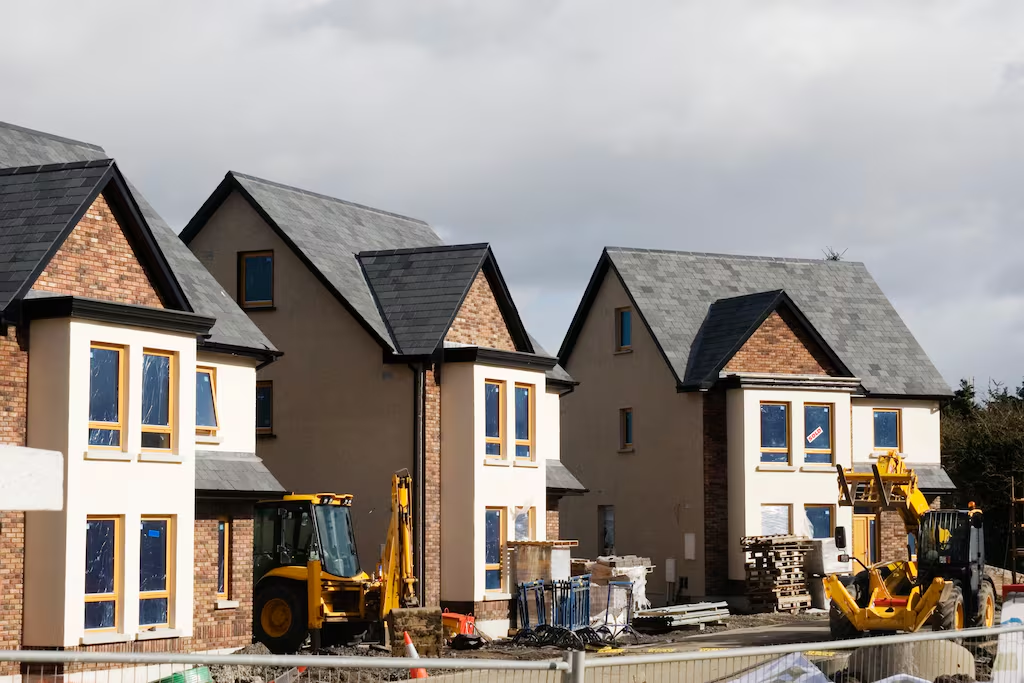Sarah Jane Kearney
Director of new homes and development at DNG
Ireland’s housing market remains under pressure in 2025, with demand still exceeding supply. This imbalance has created a highly competitive environment for buyers. January’s European Central Bank interest rate cut has improved affordability for first-time buyers, boosting demand in the new homes sector.

Government support schemes, such as the First Home and Help to Buy schemes, are a welcome boost for the housing sector. By December 2024, more than 7,000 applications to the First Home scheme underscored its importance. However, with property prices rising, a review of regional price ceilings is increasingly necessary to ensure the scheme is effective.
Encouragingly, more developments are emerging under the local authority affordable purchase scheme, providing much-needed opportunities for buyers. However, demand remains exceptionally high, with every release under the scheme oversubscribed, underpinning the urgent need for increased affordable housing supply.
Data published in January showed a record 60,243 new homes were commenced in 2024, marking an 84 per cent increase from 2023. However, only 30,330 new dwellings were completed, a 6.7 per cent decrease from 2023’s 32,525. Apartment completions fell 24 per cent from 11,542 in 2023 to 8,763 in 2024. In the fourth quarter of 2024, 8,732 new dwellings were completed.
This surge in commencements highlights strong momentum in residential construction as Ireland continues efforts to address housing supply challenges. While the increase in new projects is encouraging, some commencements may have been filed to avoid development levies. The figures signal progress for future housing supply.
Overall, the new homes market remains active, with strong demand expected to continue throughout the year and into 2026. The new government must act swiftly and decisively, implementing the programme for government’s plans. To restore balance, it must streamline planning, invest in infrastructure, prioritise affordable housing and accelerate supply to create a more accessible market.
The challenge ahead is not just building more homes, but building a future where housing is sustainable, affordable and accessible for generations to come.
Ivan Gaine
Director of commercial and new homes at Sherry FitzGerald and chairperson of Property Industry Ireland
It is disappointing to see just over 30,300 homes completed in 2024, of which, just a third were available for sale. As a business, we managed 20 per cent more new home sales in 2024 (compared with 2023) and forecast a further 20 per cent increase this year – trendlines are improving albeit off a low base. Our new minister for housing, James Browne, needs to be brave in making the correct political and policy decisions, some of which may not win universal support and needs not to overtax the system with new taxes. Planning and infrastructure need urgent attention and focus.

The programme for government contains some good, bad and ugly suggestions. We welcome the expansion of the First Home and Help to Buy schemes, and the commitment to development land audits. However, some proposals such as land value sharing taxes could hinder housing delivery and prove counterproductive.
The details of the starter home programme to deliver an average of 15,000 starter homes is encouraging if it is not just a rebrand; as always, the devil will be in the detail and aspirations set out in the programme are very much open to interpretation, and clarity and consistency will be the key to deliver across all tenures.
We have a couple of themes for 2025. Aspiring buyers now have a variety of different and expanded demand-side supports, and we are beginning to see planning permission granted for a new style of development permitted by the compact settlement guidelines, which were finalised last year.
In our role, we endeavour to promote and communicate the tenure and financing options available to buyers (First Home, Land Development Agency/local authority affordable, cost rental and so on). We inform future residents about the new housing typographies which put an emphasis of quality of public open space and should yield more viable, affordable and sustainable densities. We look forward to a busier year ahead.
Des Donnelly
New homes director at Hooke & MacDonald
There is a massive unsatisfied demand for new homes at present, both houses and apartments, but the supply is being thwarted by a number of self-inflicted obstacles, including a lack of zoned land, a flawed planning system and a significant deficit in infrastructure.
We have a real housing emergency so an immediate emergency housing programme is essential if a big increase in the delivery of sufficient new homes is to occur. Measures such as material contraventions being facilitated by the government and existing planning permissions being automatically extended, while construction viability issues are addressed, are necessary if the thousands of first-time buyers, other owner occupiers and tenants are to be housed.

Many established housebuilders and developers are struggling to retain their teams because lands that they own are stuck in the planning system or in the courts. The Planning Act that was passed in December is incapable of assisting housing delivery over the next two to three years. Despairing home buyers cannot wait that long.
Some of government initiatives are working well. The Croí Cónaithe (Cities) Scheme and the Affordable Housing Scheme are popular and have good potential; as do the Help to Buy and First Home schemes.
However, the 24 per cent fall in the number of apartments being built in 2024 is directly attributable to construction cost inflation, the rent cap and the lack of appreciation of the fact that Irish and international pension funds are essential for achieving housing delivery in Ireland. They have funded homes for more than 50,000 people since 2017 but are presently excluded from the market. The year 2025 could herald a new era for the new-homes sector but only if an effective emergency housing programme is introduced without delay.
Frank McSharry
Director of new homes at Lisney Sotheby’s International Realty
The new-homes market will remain exceptionally busy in 2025 with continued strong buyer sentiment outstripping supply. First-time buyers will be particularly active as they seek to exit the rental market or living with family, and avail of government initiatives such as the Help to Buy and First Home schemes. It is very welcome that the programme for government has pledged to extend the schemes until the end of 2029; however, we strongly recommend a review of the €500,000 [Help to Buy] threshold.

Despite the demand, there are only a limited number of new apartment schemes for sale that are available to owner-occupiers. Apartment development viability, including in prime residential locations, remains marginal in many cases. The government’s Croí Cónaithe scheme seeks to bridge this viability gap has had limited uptake to date.
While new-home completions have experienced a significant uptick since 2022, supply remains below what is required. The temporary waiver of S48 development contributions and the refunding of water and wastewater connection fees helped grow housing commencements by 73 per cent. It is unfortunate that the waivers were not extended.
There will be a further increase in the involvement of government-backed entities in the new homes sector in 2025. Last year, the Land Development Agency established a framework with 15 private-sector home builders to realise the second phase of Project Tosaigh (5,000 affordable homes).
A key market constraint that will remain in 2025 will be the deficits in infrastructure – water, wastewater, drainage, power and transport connections. This will have an impact on the industry’s ability to deliver housing at scale, particularly considering the higher targets now in place. The programme for government has pledged investment in the sector but this will need to progress rapidly to remove the blockages.
Sarah Murray
Director of new homes at Savills
Despite ongoing challenges, the new-homes market in Ireland is poised for expansion in 2025, thanks to several government policies and initiatives aimed at ramping up construction and supporting owner-occupiers. Notably, projects facilitated in 2024 by the temporary development levy waiver and water connection charge rebates are expected to bear fruit. Commencements in the fourth quarter of 2024 rose by more than 14 per cent compared with the previous year, signalling a robust pipeline of new homes set to enter the market over the coming years.

Among the anticipated developments are those backed by the Croí Cónaithe (Cities) Scheme, which supports urban residential projects. Savills New Homes is gearing up to launch the first of these apartments in sought-after locations within Dublin and Cork city. These units, targeting resident owner-occupiers, will also be accessible under the Help to Buy and First Home schemes, making them an attractive option for first-time buyers.
The variety of new developments advertised for sale in January 2025 surpasses last year’s offerings, spanning various locations, price points and property types – including traditional houses, duplexes and apartments. This diversity is crucial as it caters to a broad spectrum of buyers. Notably, the inclusion of properties suited for trade-down buyers – typically older homeowners looking to downsize – could energise the market by encouraging these individuals to sell their larger, now unsuitable homes.
As these changes take root, the increased movement and activity within the residential market are expected to invigorate all segments of the housing sector, ushering in the start of what will hopefully be a period of growth.
Will Coonan
Director of Coonan Property
As 2025 dawns, the outlook for the new homes market in the Greater Dublin Area (GDA) presents a mixture of cautious optimism and ongoing challenges. Despite some government interventions aimed at supporting affordability, the lack of sufficient housing supply remains a primary concern.

One of the most notable developments is the extension of the Help to Buy scheme, which continues to support first-time buyers until December 2029. Combined with the First Home scheme, these initiatives aim to make home ownership more accessible, particularly for those struggling with escalating house prices. However, the overall impact of these schemes has been dampened by the continuing lack of homes being built, despite financial incentives.
In 2024, house completions dropped by 6.7 per cent to just over 33,000 units, underscoring a worrying trend in the market and far short of Government targets of 50,000 annually. The majority of completed housing units were located in counties Dublin, Kildare, Louth, Meath and Wicklow. The decline was attributed to a variety of factors, including cost inflation for construction, particularly relevant to the higher-density apartment schemes; labour shortages; and challenges posed by a poor supply of zoned land, sites with a marketable planning permission and serviced with the required utilities and essential infrastructure.
While the extension of government support schemes and recent adjustments to price caps within the First Home scheme are positive steps, they have not yet fully addressed the supply-side issues.
On a brighter note, green mortgages are emerging as an attractive option, aligning with the growing emphasis on sustainability. These products, offering lower interest rates for energy-efficient homes, are helping incentivise both builders and buyers to consider eco-friendly options, albeit their impact may take time to fully materialise.
Ultimately, while there are signs of progress, the GDA’s housing market in 2025 will likely remain challenged by persistent supply constraints, despite the best efforts of both policymakers and industry players.
Ray Palmer-Smith
Director of new homes at Knight Frank
Strong population growth and a robust economy, characterised by rising employment levels and sustained wage growth, will continue to support the demand for new homes in 2025. Additional interest rate cuts in 2025 will also ease affordability pressures and further strengthen buyer appetite.

The conclusion of the general election campaign and the election of a new Government is also positive, removing the uncertainty in relation to the Help to Buy and First Home schemes, which will now be extended until the end of 2029.
We anticipate that supply will recover marginally in 2025 following a lower-than-hoped-for out-turn last year when just 30,330 units were completed, a decrease of 6.7 per cent compared with 2023.
Construction of a record 60,243 units commenced last year, aided by waivers on development levies and rebates on water charges. While there is some uncertainty as to how many of these commencements will lead to completions, we estimate that about 35,000 units will be delivered in 2025. This is still well short of the 60,000 units annually that Knight Frank predicted would be required to meet demographic pressures, a figure that is now enshrined in new national housing targets and the programme for government.
Prices pressures will continue as demand continues to outstrip supply. Annual price growth for new homes reached 6.4 per cent between the third quarter of 2023 and the third quarter of 2024. Increased supply is the most important thing required in order to ease these price pressures, particularly against a backdrop of full employment and government subsidies for first-time buyers.
Measures to free up Ireland’s slow and unpredictable planning system as well as a step change in the provision of zoned and serviced land and funding are required to hit this level over the coming years.











